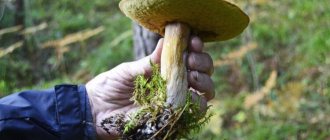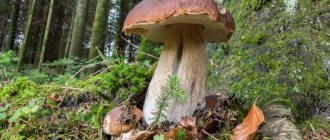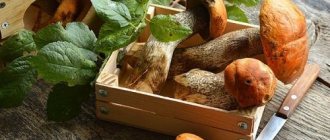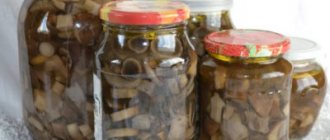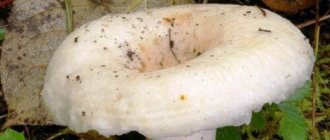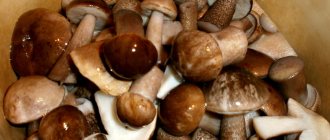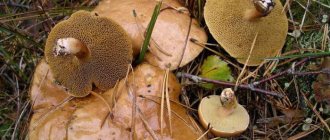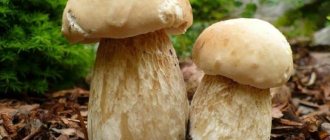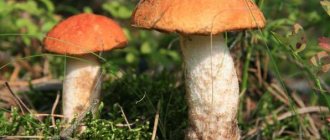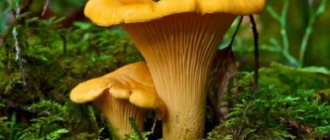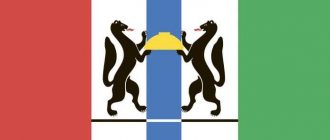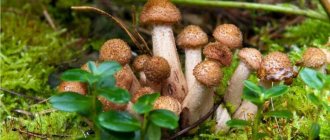The fact that it is necessary to look for boletus in places where aspen grows has been known for a long time. This, in particular, is indicated by the name of the mushroom. It is also known as redhead, red mushroom, aspen mushroom, multi-skinned mushroom, red mushroom, red mushroom.
Boletus is classified as a group of elite mushrooms due to its exquisite taste and bright nutty aroma. The cap of the redhead can have different colors depending on the amount of sunlight it receives and the moisture it receives. Boletus grows, like many other mushrooms, only at certain times and in places suitable for it.
Where do aspen mushrooms grow?
Boletuses (pictured) grow in almost any forest. They can be found both in aspen forests and in mixed plantings - coniferous or deciduous. It is unlikely that you will be able to find redheads in a pure spruce forest. During hot and dry periods, they most often grow in young aspen groves.
Redheads can choose absolutely any place for themselves. Most of all they like forest areas protected from direct sunlight and blown by light warm winds. They love wet lowlands, shady bushes, woodlands overgrown with various grasses or moss.
Boletus is a name given to a whole group of mushrooms belonging to the botanical family Boletaceae of the genus Leccinum. They differ mainly in the size and color of the cap. At the same time, different types of boletus grow only in places suitable for them.
Boletuses - what's special about them?
Firstly, they have no poisonous counterparts in the entire mushroom kingdom. There are inedible mushrooms that are somewhat similar to them, but it is even more difficult to confuse redhead mushrooms with them than boletus mushrooms.
Secondly, of the entire numerous tribe of tubular mushrooms, boletus mushrooms are one of the most photogenic. They look very impressive against the background of rotten and fallen leaves, in moss, and in short grass. Those who combine quiet hunting with photo hunting will like redheads.
Thirdly, in terms of their taste, aspen mushrooms are in second place after porcini mushrooms - on a par with boletus mushrooms, boletus mushrooms and other mushrooms. And in terms of cooking, they are universal: they can be boiled, fried, stewed, made into sauces and mushroom caviar, baked in a pie. If you want to prepare for future use, please: drying, pickling and even salting. You can also boil the mushrooms - this will significantly reduce them in size, and then freeze them.
In my opinion, the best place for boletuses is soup, because here they give a lot of fat. Mushrooms can also be stewed in several ways and served with fried potatoes as a side dish.
Something about names and places of growth
At first glance, it may seem that everything is simple here. Boletuses means those growing under aspen trees. However, there is also a version that the mushrooms got their name not so much for their preference in choosing a symbiont tree, but for the similarity of the color of their caps with the autumn leaves of aspen, which, as is known, usually have a bright color - towards orange-red shades. And some of the redheads even prefer other plants to aspen - this only confirms this version.
Another interesting nuance that is directly related to the places where mushrooms grow (and to botany): aspen in the scientific world is also known as “trembling poplar,” and for good reason - this tree is really one of the types of poplars and is quite close to the notorious object of urban landscaping - manufacturer of annoying flying fluff. Therefore, most redheads are found in those forests where there are not only aspens, but also other poplars.
On the banks of some of our Ural rivers, poplars are very common, and in some places there are entire poplar tracts. When I was young, I wondered what kind of mushrooms were found there? I imagined something “exotic” - like champignons. Once I happened to find myself in such a poplar forest during the mushroom season. Imagine my surprise when I discovered there the owners of red caps I already knew - regulars in almost any mixed forest.
Types of boletuses
All redheads are edible and have the same nutritional value, so it is often difficult for mushroom pickers to distinguish them. In order not to confuse boletus with other mushrooms during collection, you need to know what a particular variety looks like and study their distinctive features and characteristics.
The main representatives of the genus are considered to be white, red and yellow-brown redhead. Other species include pine, oak, paintedfoot and blackscale.
Red (Leccinum aurantiacum)
Main characteristics:
- The cap is red, red-brown, red-red or orange.
- Leg height – 5-17 (20) cm.
- Thickness – 1.2-2.6 (6) cm.
- Cap diameter – 5-20 (30) cm.
It is found in the forest zone of Eurasia, in the northwestern and European parts of Russia, in Siberia, the Urals, the Caucasus, and the Far East.
Yellow-brown (Leccinum versipelle)
The mushroom cap is yellow with a brown or orange tint. Leg height – 7-23 cm. Thickness – 1.5-4 (7) cm.
Grows in northern regions with a temperate continental climate. In the European part of Russia, in the Far East. In lowland birch, aspen, spruce-birch and pine-birch forests.
White (Leccinum percandidum)
The cap of the species is white, gray-brown, its diameter is 4-16 (25) cm. The height of the stem is 4-10 (15) cm, thickness is 1.2-3 (7) cm.
A rare species found in Moscow and the Moscow region, in Siberia, Chuvashia, Western Europe, North America, and the Baltic countries.
Painted foot (Leccinum chromape)
Pink hat. Pink and red scales cover the entire surface of the leg. It is white-pink at the top, yellowish at the bottom. Distributed in East Asian and North American countries.
Pine (Leccinum vulpinum)
The hat is velvety to the touch, red-brown with a crimson tint. Leg height – 10-15 cm, thickness – 2-5 cm. Cap diameter – 15 cm or more.
Grows in European countries with temperate climates.
Oak (Leccinum quercinum)
Red or orange cap. Leg height – up to 15 cm, thickness – 1.5-3 cm. Cap diameter – 8-15 cm.
Has some similarities with boletus. Partner tree - oak. Grows in northern latitudes with temperate climates.
Blackscale (Leccinum atrostipiatum)
The cap comes in a variety of colors, from deep red to red-orange to terracotta red. Leg height – 8-13 cm, thickness – 2-4 cm. Cap diameter – 5-15 cm.
Grows in oak groves and mixed plantings of the northern regions.
Attention! White boletuses are listed in the Red Book, so collecting them is prohibited. By cutting just one mushroom, thousands of spores will be destroyed, from which mycelium could subsequently develop.
How to distinguish edible and false boletus: comparison, differences
Boletus is a beautiful and safe mushroom. Almost all varieties are considered edible. Therefore, if you know exactly what they look like, you can collect them without any problems, without fear for your own health.
But sometimes many mushroom pickers have a question: how to distinguish a false one from an ordinary one? In fact, there is no false mushroom in nature. People often confuse it with mustard. This representative looks very much like a simple boletus.
Gorchak has a bitter taste. But you won’t try it until you distinguish it from a good boletus. It is very difficult to distinguish a normal boletus from a false mushroom by external indicators. But be that as it may, it can still be done.
False and edible
- First, take a closer look at the color of the mushroom. Cut it. Look, the false mushroom has a slightly reddish or pinkish tone. Real aspen boletus is white when cut, sometimes its color is bluish.
- The next sign is an unusual mesh present on the stem of the mushroom. The false representative has this mesh of a reddish or yellowish tint. On an ordinary real mushroom, such additional inclusions are simply absent. Boletus has an even, beautiful tone.
- Also, do not forget that “false flowers” can grow exclusively in coniferous forests. You can find such mushrooms near pine and spruce trees. But normal boletuses grow only near deciduous trees.
As you noticed, the absence of sufficiently pronounced toxicity does not mean that the specimen is considered edible. Therefore, if you decide to go boletus hunting, take a special guide with you. It would be better if it described all representatives of this category of mushrooms, their colors, and presented photographs. Also, the directory should contain photographs of false mushrooms so that during harvesting you definitely do not confuse them.
Why do boletuses grow under aspen trees?
The boletus got its name due to the similarity of the color of the cap with the color of the autumn leaves of the aspen, as well as because of its close symbiosis with it. At its core, the redhead is a parasite. The mycelium penetrates the root system of the tree, thereby forming a special adhesion called mycorrhiza. Thus, an exchange process occurs between them. The boletus receives from aspen the organic substances necessary for full development and growth. In return, the mushroom gives the partner tree water and minerals.
This mutual exchange has a beneficial effect on redheads. Therefore, most often you can find boletuses in the forest under aspen trees.
Comment! Despite its name, boletus can also be found under other deciduous trees, such as birch, oak, and poplar.
Chemical composition
The taste of boletus is very similar to a porcini mushroom. It is in no way inferior to the boletus. The chemical composition makes boletus not only tasty, but also healthy; it is a very nutritious mushroom. It contains proteins, fats and carbohydrates, as well as dietary fiber, fatty acids (saturated and unsaturated), mono- and disaccharides, and B vitamins.
Among the minerals, potassium, phosphorus, iron and sodium should be noted.
The protein contained in boletus can replace animal protein. These are high-quality elements that can significantly enrich the diet.
The boletus mushroom has a calorie content of only 22 kcal per 100 g. This classifies this product as low-calorie. It is also considered to take a long time to digest.
When do aspen boletuses grow?
The growth of redheads occurs in layers or periods, like many other mushrooms. The first single specimens appear already at the beginning of summer, but boletuses begin to grow en masse a little later - in July. Mushroom growth continues until autumn, until the onset of the first frost.
But redheads do not grow constantly, but with breaks for rest. The duration of the mushroom layer depends on the amount of precipitation and temperature conditions. The most intensive growth of mushrooms is observed in September.
The collection time for boletuses extends over a long period of time. At the same time, the first mushrooms are called differently, depending on the time of appearance:
- Kolosoviki. They appear during haymaking and during the heading of winter grain crops.
- Reapers. They begin to grow during the harvest season.
- Deciduous plants. Appear in early autumn.
Between layers and after, a rare single appearance of mushrooms is possible. This is often observed during the humid summer period, when fruiting is not very pronounced at times.
| Variety of mushrooms | Fruiting dates | Peculiarities |
| Spike boletus (white and yellow-brown boletus) | End of June and first half of July | Fruiting is not too abundant |
| Reaper (oak boletus, red boletus and black scale boletus) | Second half of July or August-September | Productivity is very high |
| Deciduous plants (spruce and red pine) | Second ten days of September and end of October | Long fruiting period right up to frost |
Comment! The long fruiting of pine and spruce redheads is explained by the fact that they grow in coniferous litter. It is this that protects the mycelium and young mushrooms from low temperatures.
Description
The boletus has a dense fruiting body with a stocky stem. The hat is red. The mushroom tastes very good. At different stages of growth, it practically does not change its appearance. But old mushrooms are different from baby ones. In young people, the cap moves forward and is completely attached to the stem. It is wide, well protects the lower part from wind, sun and other bad weather.
Expert opinion
Melnikov Vladimir Mikhailovich
Knows 1000 ways to cook, pickle and marinate any types of mushrooms
It is better not to collect old boletuses. They can be identified by color. The surface may be wet, greasy and even viscous. There are granules on it. The hat is highly fragile. A healthy mushroom has an orange-red cap, up to 20 cm in circumference. The flesh is white. When damaged, a burgundy and then grayish color appears.
The leg is up to 18 cm tall; when broken, it changes color to a green or blue hue. Over time, the lower part turns black, but this does not indicate toxicity. The mushroom is planted deep in the ground. Therefore, the leg is cut off at the very base so as not to damage the mycelium.
1- Boletus yellow-brown. 2- White boletus.
Common types:
- yellow-brown;
- pine;
- oak;
- red;
- white;
- colored-legged.
At what temperature do aspen mushrooms grow?
For the growth and full development of the mycelium, a temperature of 12 to 22 ° C is required, with a constant supply of fresh air. It lies approximately at a depth of 6-10 cm from the top layer of the earth. The boletus mycelium is perennial. It has excellent adaptability to changes in temperature conditions, so it can tolerate both drought and heat, as well as severe frosts.
In the absence of rain for a long time, the mycelium freezes and stops forming a mushroom body. Low temperatures also have a negative effect on mycelium growth. Rapid growth of boletus occurs with sufficient moisture and heat. The key to a good mushroom harvest is frequent, but not prolonged rains and moderate air temperatures. The optimal temperature is 18-20 °C.
Comment! It is quite difficult to confuse the boletus with some poisonous mushroom, thanks to its remarkable appearance - a bright cap on a high stem with dark scales.
Contraindications
The absorption of mushrooms is a rather complex process for any organism. Such foods increase the load on the liver and kidneys. Therefore, people who have problems in this area should control the amount of mushrooms consumed in their diet.
Poisoning can be caused by old or spoiled boletus. Only their young representatives are suitable for cooking.
It should be remembered that boletus spoils quite quickly. Therefore, they should be processed as soon as possible after collection. You shouldn't even store them in the refrigerator. Over time, even there the mushrooms will lose their edible suitability.
When cooked, the mushroom darkens. This shouldn't be scary. The main thing to understand is that in any case, boletus mushrooms must be boiled or fried. This will help avoid negative consequences after consuming such a product.
From all that has been said above, it should be concluded that the boletus mushroom is a fairly high-quality food product that can diversify the diet. The collection is carried out in accordance with a number of rules. The mushroom has a list of distinctive features that should be taken into account during the selection process. By approaching this activity competently and responsibly, you can collect a valuable product that is healthy and tastes excellent.
How long does the boletus grow?
Fungal growth begins as soon as the mycelium is fully developed. The boletus grows on average from 3 to 6 days, and the mushroom reaches medium size. Under optimal growing conditions, it grows to 10-12 cm in 5 days. The boletus stem stops developing 1-2 days earlier than the cap, which then grows only in width.
At the beginning of autumn, during the long rainy season, the boletus grows quite quickly, increasing by several centimeters within 24 hours. Full maturity of the fungus occurs 7 days after emergence from the soil.
As quickly as redheads grow, they deteriorate just as quickly. Their life cycle lasts about 2 weeks.
Advice! You can distinguish boletus from other mushrooms by the characteristic blue color that appears on the flesh and stem when cut. When broken, the color of the mushroom becomes purple or gray-black.
Processing and what to cook
Boletuses are delicious mushrooms. Boletus is slightly inferior in taste, but dishes made from it are no less aromatic and nutritious. Despite the high quality of the mushroom, it cannot be consumed without pre-treatment. They are soaked before boiling. Worms can settle in the boletus, which are easily removed in salted water.
Expert opinion
Melnikov Vladimir Mikhailovich
Knows 1000 ways to cook, pickle and marinate any types of mushrooms
Soaking is especially necessary if they will be stored in the freezer in the future. After cleaning the mushrooms, rinse them well. Wormy representatives should be soaked in salted water for at least 2 hours. They can then be cooked with healthy mushrooms.
The aspen boletuses are coarsely chopped and filled with cold water. The foam is removed as it appears. Then boil for about 10 minutes. After cooking, the mushrooms need to drain well. If they dry out, they will turn golden brown when fried.
Boletus mushrooms are more suitable for hot dishes than for pickling. They are used to cook soups, make stews and pies. You can also dry it for the winter. It is better to do this in the oven or on a string.
Where to collect boletuses
Experienced mushroom pickers say that it is best to look for boletuses in a mixed forest, where aspen trees coexist with birch, oak, and pine trees. Collecting mushrooms is quite simple, since they have a noticeable bright appearance, and they do not hide, but grow in plain sight. But sometimes in dense forests, boletuses are found under piles of leaves. Therefore, in the fall it is easiest to find them in coniferous plantations. Handsome redheads can be seen from afar, even in dense grassy thickets and among fallen leaves.
Boletuses do not really like loneliness, so they often grow up in large families. You can find them along aspen, birch and alder plantings. Boletuses often prefer shady thickets of pure and mixed forests, shrubs, edges overgrown with moss, ferns, grass, and blueberries. Sometimes they can even be found in swamps. Depending on the species, the redhead chooses 1-2 trees as partners.
| Types of boletuses | In which forest to collect | Preferred growing location |
| Red | In deciduous small forest (pure and mixed), young aspen growth. In a dry summer in damp tall aspen trees | In the grass, in clearings and on the sides of forest roads, under young trees |
| White | In wet birch and mixed | Any wet areas of the forest |
| Yellow-brown | Pine-birch, birch, aspen and mixed | On rocky, sandy and peaty soils, under fern leaves |
17
Mushroom pickers going on a mushroom hunt in the forest should watch a video that tells how to look for and correctly collect boletus mushrooms:
What are the best places to collect?
From mid-June to the end of July, the best place to collect boletuses is in plantings overgrown with willow, birch, aspens, small trees and bushes.
From mid-August to the end of September, collect boletus mainly in coniferous and spruce forests.
In autumn (end of September, October) good places for collecting this type of mushroom are considered to be: small forests, spruce forests, forests in the middle of the forest, pitted with holes and tubercles (due to heat and relative moisture).
Collection Tips
Boletuses grow in the shade, and the color of the cap is strongly influenced by the sun. Therefore, you should not mistake all pale-colored mushrooms for toadstool; it could very well be boletus. By the way, as for taste, color does not in any way affect their taste, so they can be safely collected. The brightest caps can be seen in sparse aspen forests, in open areas and on forest edges. Those who like to collect boletus mushrooms should know that these mushrooms do not like loneliness and most often grow in families. The best time to collect redheads is mid-summer, August and September.
Collecting such mushrooms is not difficult; they grow along birch, alder, and aspen plantings. Most often, you don’t even need to look for them: thanks to their bright color, they are happy to show themselves to mushroom pickers. If you cook them in a marinade, they become lighter in color, and if you fry the mushroom stems correctly, you can treat the whole family to a real forest delicacy.
If you dry boletus, their taste will be very similar to the taste of chips.
Collecting young boletuses is very popular among novice mushroom pickers: thanks to their bright red caps, it is not at all difficult to recognize them. If we talk about mature specimens, their cap acquires a gray tint over time, the brightness is lost, and in color they are very reminiscent of boletus mushrooms. Collecting boletuses is so popular because the mushroom has an amazing taste, and in its qualities it ranks behind the porcini mushroom.
Redheads are difficult to confuse with something else. However, there are also false boletuses that have much in common with the original, but their spongy layer is pink, yellow, red or red-brown. Another distinctive feature of false mushrooms is the red or yellow mesh on the stalk.
When the boletus is collected, the basket is always full
Black-scaled boletus Leccinum Atrostipiatum
Boletus mushroom is a famous, beautiful and tasty
mushroom from the genus Obabok, the Boletaceae family.
Appearance
The cap is up to 12 cm in diameter, initially convex, later cushion-shaped. It has a dry, velvety surface and is painted in red-orange shades.
The hymenophore is tubular; the tubes are light in color, darkening with time.
The leg is up to 18 cm long and up to 4 cm in diameter, cylindrical, with a thickening at the bottom. It is painted in light shades and covered with dark red scales.
The pulp is dense and light, has no pronounced smell or taste. It turns blue when cut and then turns black.
Where and when does it grow
Grows in mixed forests, from June to October.
Culinary use
A good edible mushroom, suitable for any type of culinary processing.
Boletus Yellow – Brown Leccinum Versipelle
Boletus mushroom is a famous, beautiful and tasty
mushroom from the genus Obabok, the Boletaceae family. Also known as Obabok the Many-Skinned.
Appearance
The cap is up to 20 or even 30 cm in diameter, initially spherical, later convex or flattened in shape. The color of the cap varies from red to yellowish-gray.
The hymenophore is tubular, the tubes are finely porous, easily separated from the cap, colored in light gray shades, becoming lighter with age.
Spore powder is yellow-brown.
The leg is up to 20 cm high and up to 5 cm in diameter, cylindrical and solid, thickening downwards, painted white, with a slightly greenish tint at the base. Covered with black and gray fibrous scales.
The pulp is light, turns purple when broken, and has no pronounced taste or smell.
Where and when does it grow
Fruits from June to the end of October, in mixed and deciduous forests. Forms mycorrhiza with birch. Peak fruiting occurs at the beginning of September.
Culinary use
An excellent edible mushroom, suitable for any type of culinary processing.
Edible mushroom very similar to boletus
The genus Leccinum includes a considerable number of mushrooms, among which there are not only boletuses, but also boletus mushrooms. Exactly one of the types of boletus, and specifically the harsh boletus
(Leccinum duriusculum) is very similar to boletus in many ways. This mushroom forms mycorrhiza with aspens and poplars, has a dense pulp structure that darkens when cut, there are often bluish spots at the base of its stem, and in general its appearance resembles a typical aspen boletus.
Have you noticed how much these mushrooms have in common? Well, now it’s worth talking about the differences. The first thing that catches your eye is the cap; the cap of the boletus boletus is grey-brown or brown; similar colors can only be found in the spruce or oak boletus. When cut, the boletus pulp does not darken immediately; initially it acquires a reddish tint and only later becomes almost black.
The tough boletus is rarely wormy. This is associated primarily with its dense pulp. It bears the greatest resemblance to boletuses at a young age, when its cap has not yet opened. In terms of nutritional value, this boletus is not inferior to boletus.
Well, my story about boletuses can be considered complete. I tried to reflect in the article the most complete information about these wonderful mushrooms, using personal knowledge, books and the Internet. I hope you found it interesting!
Composition and beneficial properties of boletus
These mushrooms are 90 percent water. They are leaders in protein, vitamins, and amino acids content. Due to its low calorie content, this product is often included in all kinds of diets. It can be used by people suffering from diabetes. Despite the fact that mushroom proteins are of plant origin, in terms of richness and benefits, mushroom protein, in its composition, is very similar to meat protein. Mushrooms can act as an alternative to both meat dishes and cereals. This is facilitated by the presence of B vitamins in their composition.
It has been established and repeatedly proven that the use of boletus helps to cleanse the body and remove toxins. The rich broth helps fight viruses, colds and helps strengthen the immune system. Containing high levels of vitamins PP helps with anemia, their amount is the same as in the liver.
